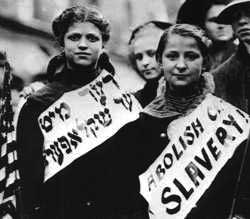
- Two Strikers during the 1909 “Uprising”
The International Ladies’ Garment Workers’ Union was founded in 1900 by seven local unions and was initially dominated by Jewish and Italian immigrants. The ILGWU will go on to be one of the only labor unions with predominantly female membership.
In New York City in 1909, 20,000 shirtwaist workers, most of whom were women, launched a fourteen month strike, known as “The Uprising.” This strike began by a bold and spontaneous action on the part of some of the workers in the Triangle Shirtwaist Factory; about 20% of the factory’s workers walked out. This emboldened others; in the next two days, about 20,000 of the factory’s 32,000 workers walked out. Over the course of 14 weeks, 700 workers were arrested, but the ILGWU was not deterred. The strike was partially successful; it won higher wages for workers. More importantly, though, it inspired others: a few months later, 60,000 cloakmakers followed suit. The success of these two movements bolstered membership in the ILGWU and granted it legitimacy in the eyes of workers and the industry. The ILGWU is a powerful union that won higher wages for its members and other important benefits, such as health checks. The tragedy in the Triangle Shirtwaist Factory resulted in resounding public support for laws that protect workers. By 1920, the ILGWU will be one of the most powerful unions in the labor movement.
The ILGWU also realized early the importance of social benefits to its members. Early on, it established sports teams and musical groups, developed housing and a health clinic for its members, and created a university that taught leadership courses, as well as citizenship and English courses. All of these extra benefits made the ILGWU one of the most powerful and effective of the larger labor movement.